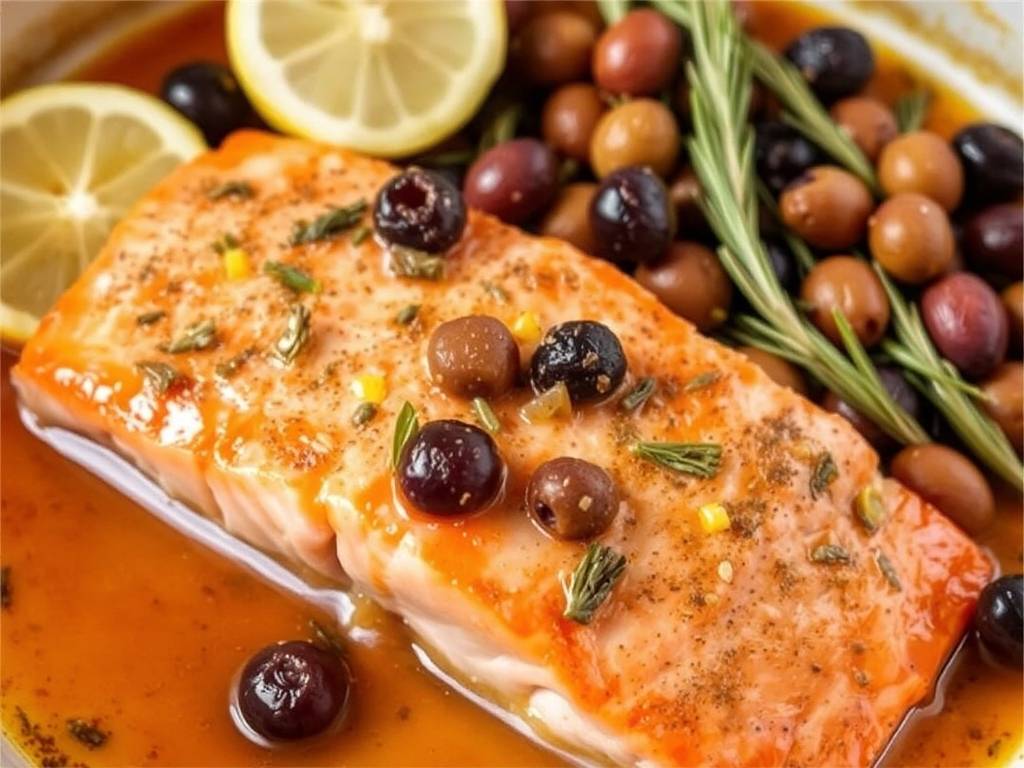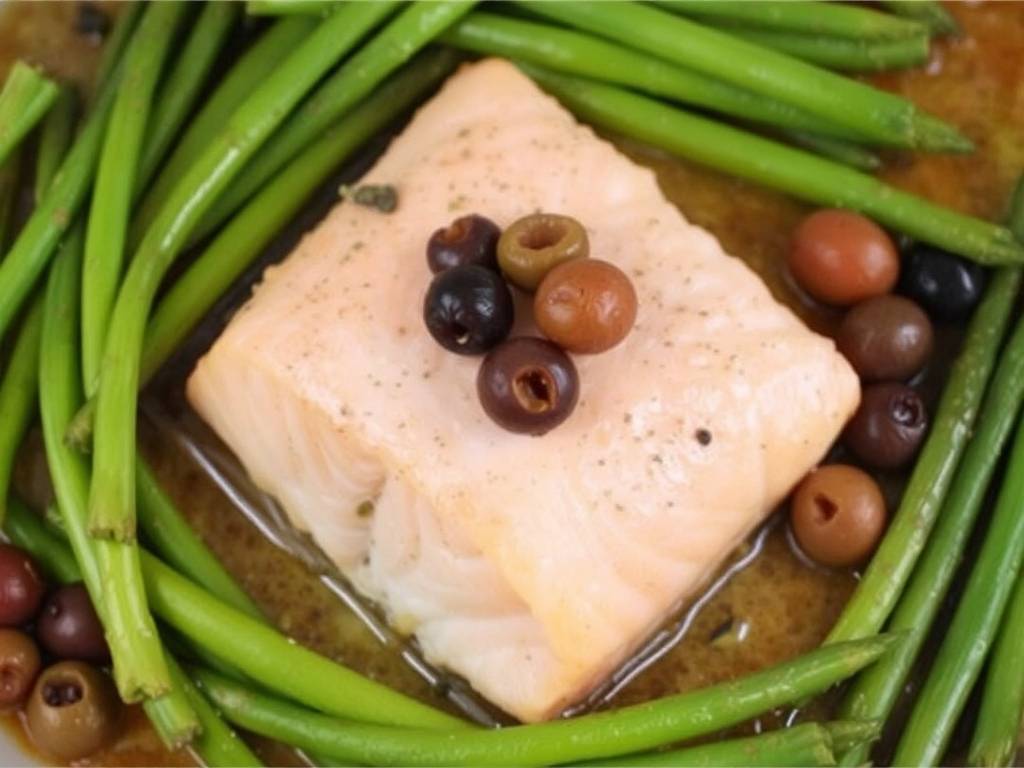The Art of Perfectly Baked Salmon with a Vibrant Olive and Caper Sauce
There exists a rare harmony in the culinary world when a simple, elegant protein meets a bold, complex sauce. Few dishes exemplify this balance as beautifully as baked salmon crowned with a vibrant olive and caper sauce. This is not merely a recipe; it is a lesson in texture, flavor, and the alchemy that happens in a hot oven. Salmon, with its rich, buttery flesh and robust character, stands up wonderfully to the salty, briny, and piquant notes of a sauce built from olives and capers. The result is a meal that feels simultaneously luxurious and effortlessly healthy, sophisticated enough for a dinner party yet simple enough for a weeknight feast.
The journey to this perfect plate begins not with the sauce, but with the star: the salmon. The choice of your fillet is paramount. Look for bright, firm flesh that springs back when touched, with a fresh, oceanic scent. The skin can be on or off, depending on your preference. Leaving the skin on can help protect the delicate flesh during baking and can be easily removed after cooking. For this preparation, center-cut fillets, each about 6 ounces, are ideal. They cook evenly and present beautifully.

Before we even think about heat, the salmon must be prepared. Pat the fillets completely dry with paper towels. This is a critical step often overlooked; a dry surface is the first secret to achieving a beautifully seared exterior rather than a steamed, pallid one. Once dry, season both sides generously with kosher salt and freshly ground black pepper. At this stage, some chefs like to add a whisper of lemon zest or a drizzle of a mild, high-quality olive oil to coat the fillets, creating a subtle flavor foundation.
Now, for the baking. The enemy of good salmon is overcooking. The goal is a flaky, moist interior with a slightly caramelized top. Preheat your oven to a confident 400°F (200°C). While it heats, choose your baking vessel. A baking sheet lined with parchment paper is functional, but for superior results, consider a cast-iron skillet or a ceramic baking dish that can go from stovetop to oven. If you have time, let the seasoned salmon sit at room temperature for 15-20 minutes. Taking the chill off the fish promotes more even cooking from edge to center.
Place the salmon fillets skin-side down (if skin-on) on your prepared baking sheet or skillet. A sprig of fresh thyme or a thin slice of lemon underneath each fillet can add a subtle aromatic steam. The high heat of the oven will quickly cook the salmon, locking in its natural juices. The general rule of thumb is to bake for about 4-6 minutes per half-inch of thickness. However, timing is a treacherous guide. The true mark of a skilled cook is knowing how to judge doneness by feel and sight. A perfectly cooked salmon fillet will be opaque throughout and will flake easily with a fork at its thickest part. For those who prefer precision, an instant-read thermometer is your best friend; aim for an internal temperature of 125°F (52°C) for medium-rare or 135°F (57°C) for medium. Remember, the fish will continue to cook for a few minutes after being removed from the oven—a phenomenon known as "carryover cooking." It is always better to err on the side of underdone; you can always return it to the oven for another minute, but you cannot reverse the dry, chalky texture of an overcooked fillet.
While the salmon is transforming in the oven, the real magic happens on the stovetop: the creation of the olive and caper sauce. This is where your creativity can shine. The base of this sauce is a classic European combination known as a salsa verde or salmoriglio, but we are building upon it with bold, Mediterranean accents.
Start with a quarter cup of high-quality extra-virgin olive oil in a saucepan over low heat. To this, add two finely minced cloves of garlic. The goal here is not to brown the garlic, but to gently infuse the oil with its flavor, taking the raw, harsh edge off. After about a minute, when the garlic is fragrant, it's time to introduce the stars of the sauce.
A half-cup of pitted olives, roughly chopped, forms the backbone. The variety is your choice and will dramatically alter the sauce's character. Kalamata olives will lend a deep, fruity, and wine-like saltiness. Castelvetrano olives offer a buttery, mild, and bright green alternative. A mix of both can create a wonderful complexity. To this, add two tablespoons of capers, rinsed and drained. If you have capers packed in salt, give them a quick soak to desalinate. The capers provide a unique, pungent burst of briny flavor that cuts through the richness of the salmon.

Now, for the elements of brightness and freshness. The zest and juice of one whole lemon are non-negotiable. The acidity is essential to balance the salt and fat. Next, a generous handful of fresh, soft herbs. Flat-leaf parsley is the classic foundation, providing a clean, grassy note. To this, add a tablespoon each of fresh chopped dill and oregano or marjoram. Dill has a natural affinity for fish, and oregano brings a subtle, earthy warmth. Chop these herbs just before using to preserve their volatile oils and vibrant color.
Stir this verdant mixture together off the heat. The residual warmth from the oil and pan will be enough to meld the flavors without cooking the herbs. Season with a small pinch of black pepper, but be cautious with salt, as the olives and capers already contribute a significant amount. Taste and adjust. Perhaps a final drizzle of raw olive oil to finish, or a pinch of red pepper flakes for a touch of heat. The sauce should be a lively, chunky, spoonable relish, not a smooth purée.
The final act is assembly. Place the hot, perfectly baked salmon fillet on a warm plate. Do not let it sit on the baking sheet, as it will continue to cook and potentially stick. Spoon a generous amount of the olive and caper sauce over the top, allowing it to cascade down the sides. The contrast is stunning: the deep coral pink of the salmon against the glistening green and purple of the sauce.
This dish is a complete experience. It pairs wonderfully with simple, neutral sides that won't compete for attention. A bed of creamy mashed potatoes, fluffy quinoa, or roasted asparagus are all excellent choices. The sauce, however, is so delicious that you'll want something to soak up every last drop. A slice of crusty, artisan bread is the perfect tool for the job.
In mastering this dish, you learn more than a recipe. You learn the importance of sourcing quality ingredients, the technique of judging protein doneness, and the art of building a balanced sauce where every component—salty, briny, acidic, and herbal—has a voice, yet sings in perfect harmony with the others. It is a testament to the fact that the most memorable meals are often born from simplicity, confidence, and a deep respect for the ingredients on your plate.






发表评论